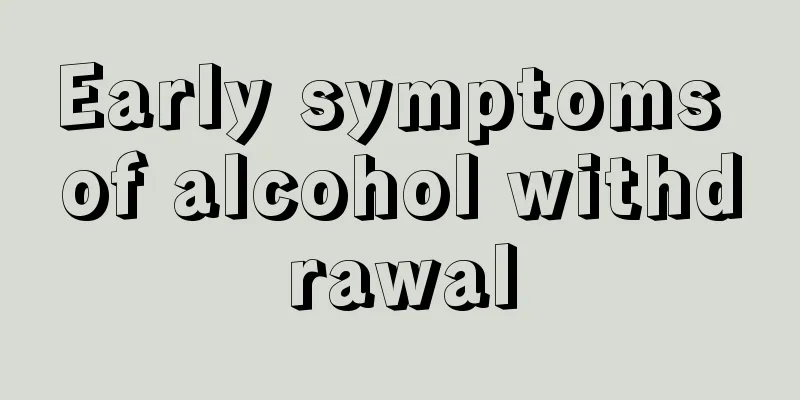Early symptoms of alcohol withdrawal

|
In our country, 70% of men drink alcohol. Drinking has become an indispensable activity in social occasions. Discussions on cooperation and feelings are all over the wine. In fact, drinking too much alcohol will cause delays. Alcohol will stimulate the human nerves and make people excited. Too much alcohol will cause hallucinations and even alcohol poisoning. Therefore, quitting drinking is imperative. So, what are the symptoms in the early stages of quitting drinking? Alcohol abstinence refers to the use of some medications or therapies to help long-term drinkers get rid of their mental and physical dependence or craving for alcohol. Alcohol dependence and chronic alcohol poisoning caused by long-term and heavy drinking not only have adverse effects on one's body, nervous system, and psychological state, but also affect family relationships, marital relationships, and bring about a series of work and social problems. People who are quitting drinking should drink more water, eat more green leafy vegetables, and avoid carbonated beverages. Psychological dependence Alcoholics have an urgent psychological need to drink, and satisfying this need is even more important than appetite, sexual desire and sleep. Regardless of the harm that alcohol may cause to the individual's mind or body and to the family or society, there is a strong desire to drink, leading to an uncontrollable search for alcohol. This obvious psychological dependence often occurs after severe physical dependence occurs, and the patient's fear of withdrawal symptoms causes him to develop obvious psychological dependence. Physical dependence Physical dependence refers to repeated drinking that causes certain physiological and biochemical changes in the central nervous system. It requires alcohol to be constantly present in the system in order to avoid withdrawal symptoms. Once you stop drinking, a series of physical symptoms will occur, such as nausea, vomiting, palpitations, sweating, etc. If you continue to use it, these symptoms can be alleviated or eliminated. Withdrawal syndrome is a syndrome that is reinforced by years of excessive drinking. Once drinking is stopped, a variety of clinical symptoms will appear, which are generally divided into early withdrawal symptoms and late withdrawal symptoms. The earliest common symptoms include: anxiety, depression, loss of appetite, nausea, vomiting, palpitations, sweating, and tremors in the hands, feet, and torso. These symptoms usually occur 7-8 hours after stopping drinking. Then some perceptual abnormalities appear, such as distorted vision, visual hallucinations, auditory hallucinations, etc. Impaired consciousness and agitation often occur about 48 hours later. Abstinence from alcohol for 72 to 96 hours is the late withdrawal symptom of alcohol dependence, which is often accompanied by delirium tremens, fever, sweating, tachycardia, increased blood pressure, mydriasis, abnormal liver function, dehydration and electrolyte imbalance. Generally speaking, withdrawal symptoms last for 3-4 days in mild cases and are relieved after deep sleep. In severe cases, they can last for more than 1 week or even longer. Patients with tolerant alcohol dependence tend to drink more and more alcohol during their young and middle-aged years, which means that their tolerance to alcohol gradually increases. Tolerance means that the original pharmacological effect can only be achieved by increasing the amount of alcohol consumed. Tolerance reaches its highest level in young adults, and as people age, their tolerance to alcohol decreases. For example, before the age of 40, a patient needs to drink about 750 grams of alcohol a day to get drunk, but after the age of 50, he will get drunk after drinking about 400 grams of alcohol a day, causing his drinking volume to no longer reach the original level. In other words, the patient's tolerance to alcohol decreases. |
<<: The difference between Judo and Taekwondo
>>: Is cardia relaxation a serious disease?
Recommend
How long does gout pain last?
With the improvement of daily living standards, s...
What are the symptoms of advanced ovarian cancer
What are the symptoms of advanced ovarian cancer?...
What are the symptoms of advanced lung cancer?
Lung cancer has a variety of symptoms in the late...
Carbon monoxide uses
Carbon monoxide is a relatively common chemical g...
Is nasopharyngeal angiofibroma serious?
Nasopharyngeal angiofibroma may cause serious com...
Early diagnosis method of colon cancer
The large intestine includes the colon and rectum...
Difference between nasal concha hypertrophy and nasal polyps
Turbinate hypertrophy and nasal polyps are both v...
Sequelae of nasal bone fracture
The nose is a key part of our facial beauty, and ...
The type of colon cancer can help patients better judge their condition
In recent years, the incidence of colon cancer ha...
There are many insect bites on my body
Everyone's skin condition is different. Some ...
Blurred vision is a sign of liver abnormality
In Chinese medicine theory, the liver opens up to...
Pain in the right side of the chest and back
Pain in the right side of the chest and back is a...
How to effectively adjust poor sleep during menopause
Women in menopause are prone to poor sleep, which...
Is the mortality rate of tongue cancer high?
Although today's living standards are constan...
The harm of long sleep time
After a busy day or during holidays, many people ...









